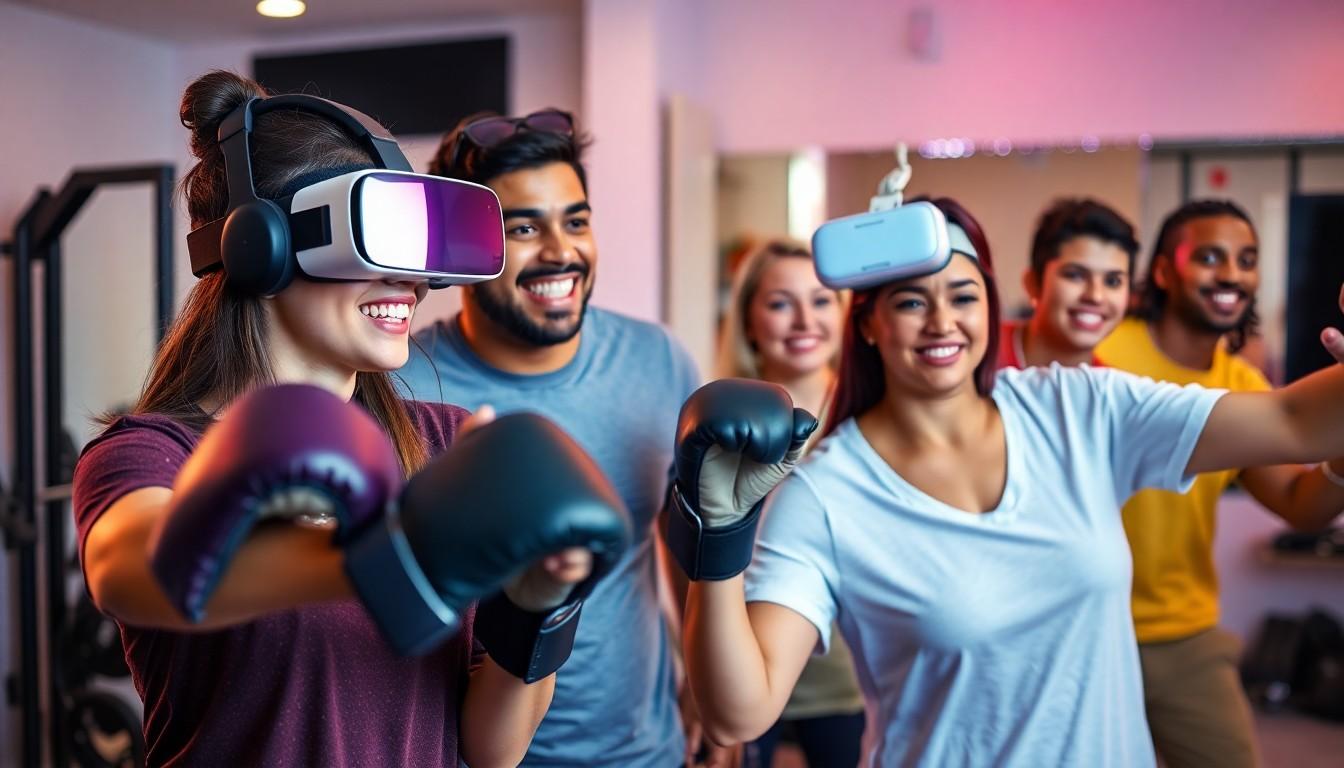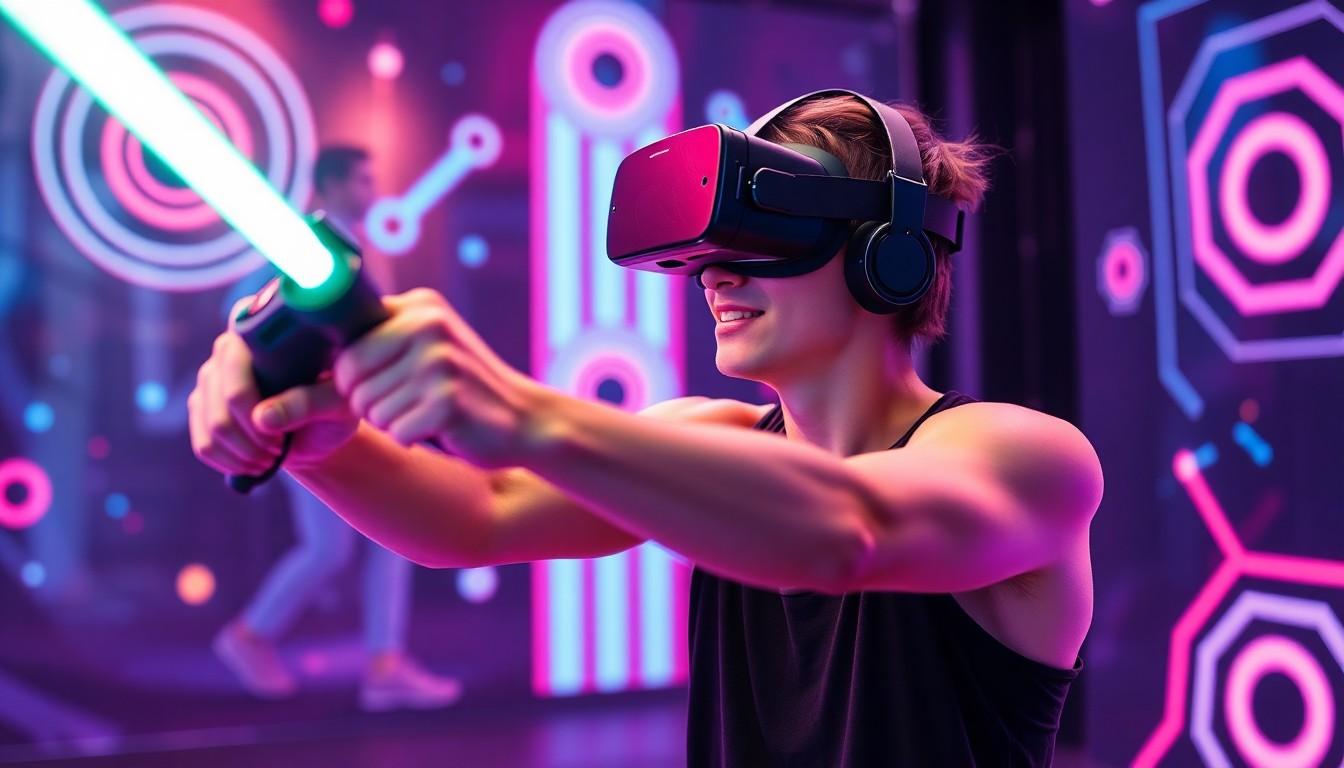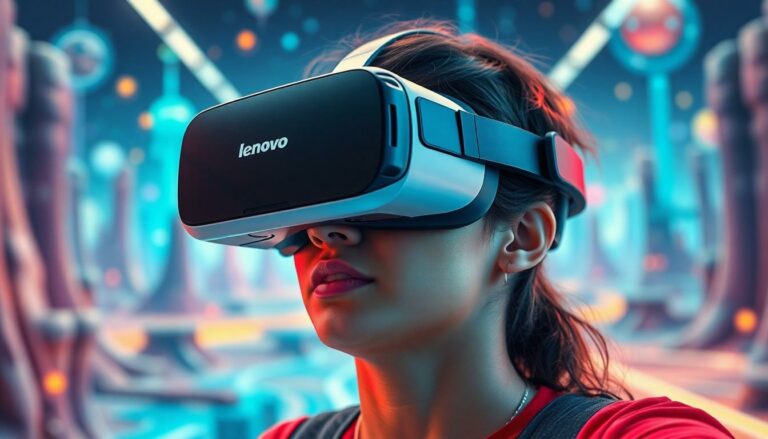Table of Contents
ToggleImagine sweating it out while battling virtual dragons or dancing like nobody’s watching in a neon-lit world. VR fitness games are not just a trend; they’re a revolution in how people approach exercise. Gone are the days of monotonous workouts that have you counting down the seconds until they end. With immersive technology, fitness has become an adventure that’s as fun as it is effective.
Overview Of VR Fitness Games
VR fitness games combine gaming elements with physical exercise, creating an engaging workout experience. Users enjoy immersive environments where they can challenge themselves while staying active. These games often include activities like boxing, dancing, and obstacle courses, appealing to various interests and fitness levels.
Many popular VR fitness games prioritize user engagement and goal setting. “Beat Saber” allows players to strike blocks while following musical beats, delivering a fun cardiovascular workout. “Supernatural” offers full-body workouts in stunning landscapes, catering to different exercise preferences. Each game presents unique challenges that keep users motivated and coming back for more.
Data from recent studies indicates that VR fitness games increase users’ physical activity levels by up to 30%. This significant boost suggests VR can effectively combat sedentary lifestyles. Additionally, research shows that users who play VR fitness games report higher levels of enjoyment compared to traditional workouts, which enhances overall adherence to exercise routines.
Platforms such as Oculus Quest and PlayStation VR host a variety of these games, making them accessible to a broad audience. With advancements in technology, VR devices have become more affordable and user-friendly, attracting fitness enthusiasts and casual gamers alike.
Overall, VR fitness games revolutionize how individuals approach exercise, transforming mundane routines into exciting adventures that promote physical activity, community interaction, and personal growth.
Benefits Of VR Fitness Games

VR fitness games offer unique advantages, enhancing the exercise experience significantly. They engage users beyond traditional methods, making fitness enjoyable and sustainable.
Improved Engagement
Gamification elements create an immersive and interactive environment in VR fitness games. Participants become deeply involved, focusing on gameplay and forgetting they’re even exercising. Dynamic challenges keep boredom at bay, leading to longer workout sessions. Studies reveal that enjoyment levels for VR workouts exceed 30% compared to conventional exercise routines. This high engagement encourages consistent participation, making fitness goals more attainable. Players often form social connections during multiplayer sessions, promoting a motivating community atmosphere.
Full-Body Workouts
VR fitness games provide excellent full-body workouts by incorporating multiple muscle groups during play. Activities such as boxing and dancing require cardiovascular movement, strength, and flexibility, ensuring a comprehensive fitness regimen. Each game targets different areas of fitness, contributing to improved muscular endurance and toning. Research shows that participants can burn up to 600 calories per hour, similar to high-intensity interval training. Additionally, customizable difficulty settings cater to various fitness levels, making it accessible for everyone. Engaging in full-body workouts through VR not only promotes physical health but also enhances coordination and balance.
Popular VR Fitness Games
Various VR fitness games engage users while promoting physical activity. Two standout examples include “Beat Saber” and “Oculus Move,” both of which offer unique experiences.
Beat Saber
“Beat Saber” combines rhythm with physical activity, creating an exhilarating gameplay experience. Players slice through musical blocks using lightsabers, enhancing agility and coordination. This game focuses on timing and movement, providing an energetic workout that strengthens upper body muscles. Users often burn between 200 to 400 calories in a single session, depending on intensity. The engaging soundtrack and immersive visual elements contribute to players’ enjoyment, making exercise feel like fun rather than a chore. Customizable settings adapt to individual skill levels, ensuring that both beginners and fitness enthusiasts find value in gameplay.
Oculus Move
“Oculus Move” tracks users’ physical activity across various VR experiences, providing insights into workout performance. This built-in feature promotes accountability by recording calories burned, active minutes, and fitness goals. Users can participate in a variety of VR games, from boxing to dance, benefiting from a diverse workout regimen. Encouraging social interaction, “Oculus Move” allows friends to engage in friendly competition, further motivating users to stay active. The emphasis on tracking progress cultivates a sense of achievement, reinforcing the commitment to fitness. Overall, “Oculus Move” enhances the VR fitness experience through monitoring and engagement.
How To Choose The Right VR Fitness Game
Choosing the right VR fitness game involves understanding personal fitness preferences and utilizing available resources effectively. Several factors play a key role in this decision-making process.
Consider Your Fitness Goals
Fitness goals can vary widely among users. Some may seek to improve cardiovascular health, while others aim to build strength or enhance flexibility. Identifying specific objectives helps narrow down game choices. For instance, games like “Beat Saber” focus on cardiovascular endurance and agility, while others may target strength training or yoga. When aiming for weight loss, players should consider intensity levels, as high-energy games can burn up to 600 calories per hour. Aligning game features with fitness goals maximizes motivation and enjoyment.
Assess Available Equipment
Evaluating available equipment is essential for optimal game selection. Depending on the VR platform, users might need specific headsets or accessories. Popular systems such as Oculus Quest or PlayStation VR offer unique experiences, and understanding the hardware capabilities benefits game performance. Moreover, checking room size for safe movement ensures players can fully engage with the game. Having the right setup maximizes immersion and functionality. Additionally, verifying software compatibility can prevent frustration and enhance the overall experience. Ensuring the necessary technological resources will lead to a satisfying VR fitness journey.
Future Trends In VR Fitness
VR fitness is evolving rapidly, with several key trends shaping its future. Enhanced immersive experiences will become commonplace as technology advances. Users can expect more realistic environments and interactive scenarios that engage them physically and mentally.
Gamification elements are set to grow in prominence. Developers will integrate more challenges, rewards, and community features to foster competition and collaboration among players. This shift aims to increase motivation and adherence to fitness routines.
Artificial intelligence is likely to play a significant role. AI will help personalize workouts by analyzing users’ performance, preferences, and fitness levels, thus creating tailored experiences. This customization will cater to a broader audience, ensuring users experience workouts that resonate with their specific goals.
Social interaction within VR fitness will also see expansion. Users will connect with friends and other players in shared spaces, enhancing motivation through accountability. Collaborative games and challenges can foster a sense of community that complements the individual benefits of exercising.
Platforms will continually improve to accommodate diverse lifestyles. Portable VR systems are expected to gain traction, allowing users to engage in fitness activities anywhere. This convenience aims to address barriers like limited space or time constraints.
VR fitness games are on track to redefine exercise. As technology progresses, users will enjoy more immersive, personalized, and socially interactive experiences. The continuation of these trends promises to enhance engagement and transform fitness into a seamless part of everyday life.
VR fitness games are revolutionizing the way people approach exercise. By merging gaming with physical activity, these immersive experiences make workouts enjoyable and engaging. With options that cater to various interests and fitness levels, users can find a game that resonates with their personal goals.
As technology continues to advance, the future looks bright for VR fitness. Enhanced experiences and personalized workouts will likely keep users motivated and accountable. With the potential for social interaction and community building, VR fitness games are set to transform exercise into an exciting and integral part of daily life. Embracing this innovative approach could lead to healthier lifestyles and increased physical activity for many.






